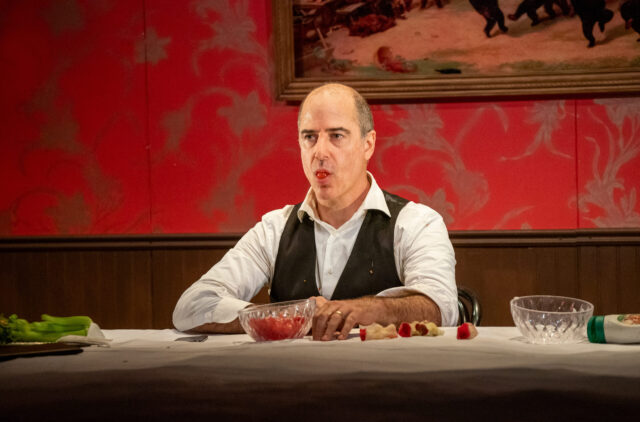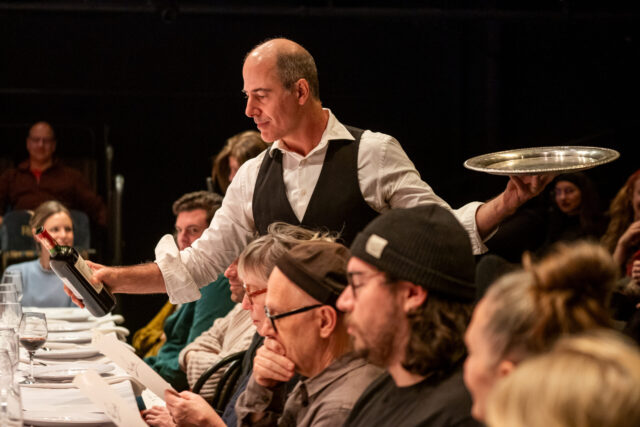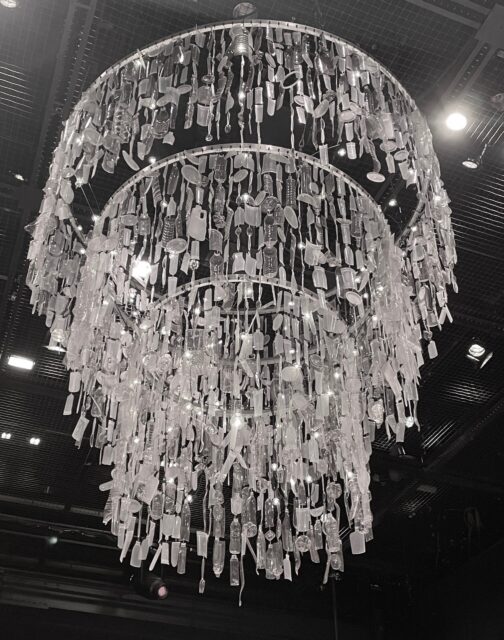
Geoff Sobelle enjoys quite a meal in Food (photo by Stephanie Berger)
FOOD
BAM Fisher, Fishman Space
321 Ashland Pl.
November 2-18, $20
718-636-4100
www.bam.org
www.geoffsobelle.com
In his 1825 book Physiology of Taste or Meditations on Transcendental Gastronomy, French lawyer and culinary expert Jean Anthelme Brillat-Savarin wrote, “Tell me what you eat and I shall tell you what you are,” which eventually morphed into the simpler, more familiar phrase “You are what you eat.”
If that is true, I have genuine concerns for theater artist Geoff Sobelle.
The Brooklyn-based Sobelle is back at BAM’s appropriately named Fishman Space — yes, seafood is on the menu — with Food, his latest foray into magical storytelling that includes HOME and The Object Lesson. But getting a ticket might be harder than reserving a table at one of the city’s hottest restaurants.
The eighty-minute piece might feed your hunger for unique and unusual entertainment, but it won’t satisfy your stomach; no food or drink is served, although it will be seen, sniffed, and touched. But Sobelle will satiate your appetite for pure, unadulterated pleasure with the show, in which he reimagines the concept of “farm to table” as he explores humanity’s overconsumption and preference for capitalism at the expense of the natural environment.
Sobelle is an ingenious storyteller, incorporating unexpected props, analog technology, and audience participation into his presentations. Food unfurls around a large dinner table with fancy place settings, evoking both Judy Chicago and Luis Buñuel; ten audience members are seated on each of three sides, with several rows of traditional rafters behind them. Above the table is a large chandelier made of recycled plastic kitchen items, including bottles, cups, knives, spoons, and containers.

Geoff Sobelle pours wine in ingenious solo show Food (photo by Stephanie Berger)
Sobelle appears about fifteen minutes before the official start time, speaking with the ushers and scouting the crowd for potential contributors. He begins the evening with a meditative session asking the audience to close their eyes and imagine themselves back in the primordial ooze from which life emerged, all the way through to the current age, where human greed is on the verge of destroying the planet.
He then pours wine for those sitting at the table and gives several people menus; he brings each a plate with a microphone on it and takes their orders. The menus contain prompts that kick off food-related shtick that is very funny while also making salient points about where our food comes from and how and where we eat it. For example, when the person next to me ordered a baked potato, Sobelle planted seed pieces in dirt and then pulled the potato from the mound, wrapped it in aluminum foil, held a lit match under it, and had our side of the table pass the “hot potato” to the expectant orderer.
Some of the prompts ask the audience member to describe a favorite meal and how to make it, leading to some exquisitely detailed recipes related off the cuff. As I hungrily listened to these descriptions, my mind raced, wondering what I would say if Sobelle brought the microphone to me.
A significant portion of the enjoyment of the show relies on the improvisatory skills of the audience, which will of course change every night. Judging from photos I’ve seen of what Sobelle has eaten at other performances — I don’t want to give anything away, but he does devour a rather unique meal, one that is beyond awe-inspiring and far from mouthwatering — his menu changes each evening as well, a commentary on gluttony of all sorts, not just comestibles.
Sobelle accomplishes various tricks and sleight-of-hand with frequent collaborator Steve Cuiffo, an illusionist who revealed his lifelong relationship with magic in Lucas Hnath’s A Simulacrum. Also contributing to the warm and intimate atmosphere of fun and fascination are lighting designer Isabella Byrd and sound designer Tei Blow. Sobelle codirects the show with Lee Sunday Evans, who has helmed such unique theater pieces as Dance Nation, Intractable Woman: A Theatrical Memo on Anna Politkovskaya, and Sobelle’s HOME, in which dancers and designers build a house onstage and move in.

A chandelier of recycled plastic hangs over an immense dinner table in Food at BAM (photo by twi-ny/mdr)
Once Sobelle is finished with his “meal,” he transforms the table into something else entirely and takes off on another narrative into the past, with a series of surprises that are simply dazzling and filled with amazement. Again, I don’t want to spoil it, but I do have to admit that one particular object, a well-known holiday toy, took me back to my childhood, as did a discussion of diners. Suddenly I was ten years old, ordering the twin-cheeseburger platter and asking my father if, like him, my “potato and vegetable” side dishes could be French fries and French fries. Sobelle’s show goes from the macro to the micro, revealing the who, what, where, when, and how behind the cultivation, acquisition, consumption, and cost of food and other items, making us question their impact on the health, and wealth, of our nation.
But a final word of caution: You are probably better off eating before the show than after, as the environmental cost of food will have a deep-seated effect on your appetite.
[Mark Rifkin is a Brooklyn-born, Manhattan-based writer and editor; you can follow him on Substack here.]